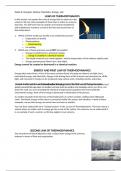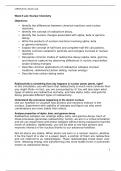Chem120 week 6 Study guides, Class notes & Summaries
Looking for the best study guides, study notes and summaries about Chem120 week 6? On this page you'll find 79 study documents about Chem120 week 6.
Page 2 out of 79 results
Sort by
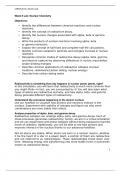
-
CHEM 120 Week 6 Virtual Lab; Nuclear Chemistry.
- Other • 11 pages • 2023
- Available in package deal
-
- $20.99
- + learn more
Week 6 Lab: Nuclear Chemistry Objectives: • Identify the differences between chemical reactions and nuclear reactions. • Identify the concept of radioactive decay. • Identify the nuclear changes associated with alpha, beta or gamma decay. • Write the products of nuclear reactions involving alpha, beta or gamma emissions. • Explain the concept of half-lives and complete half-life calculations. • Identify common subatomic particles and energies involved in nuclear reactions • ...
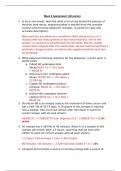
-
CHEM 120 Week 6 Assignment; Energy, Nuclear Chemistry, (20 points)
- Other • 4 pages • 2023
- Available in package deal
-
- $20.99
- + learn more
1. In your own words, describe what is occurring during the process of electron beta decay, explaining what is ejected from the unstable nucleus and focusing subatomic changes. (2 points for clear and accurate description). 2. Write balanced chemical reactions for the following: (1 point each, 4 points total) a. Cobolt-60 undergoes beta decay b. Americium-241 undergoes alpha decay c. Copper-60 undergoes positron emission d. Gallium-66 undergoes electron capture 3. Strontium-89 is an is...
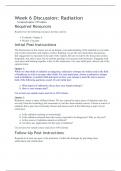
-
CHEM 120 Week 6 Discussion; Radiation (Option 1; Radioactive Isotope; Cobalt-60)
- Other • 4 pages • 2023
- Available in package deal
-
- $18.48
- + learn more
Option 1: While we often think of radiation as dangerous, radioactive isotopes are widely used in the field of healthcare as well as in many other fields. For your initial post, choose a radioactive isotope used in healthcare or another field and report on how your isotope is used. Be sure to answer both of the following questions as part of your initial post: a. What type(s) of radioactive decay does your isotope undergo? b. How is your isotope used? Use at least one outside source and ci...
CHEM 120 Week 6 Concepts; Nuclear Chemistry, Energy, and Biochemistry Part 1
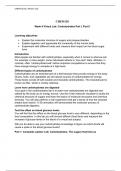
-
CHEM 120 Week 6 Virtual Lab; Carbohydrates Part I, Part II
- Other • 3 pages • 2023
- Available in package deal
-
- $20.99
- + learn more
Learning objectives • Explain the molecular structure of sugars and polysaccharides • Explain digestion and appreciate the complexity of the human body • Experiment with different foods and measure their impact on the blood sugar level Introduction Most people are familiar with carbohydrates, especially when it comes to what we eat. For example, to lose weight, some individuals adhere to “low-carb” diets. Athletes, in contrast, often “carbohydrate-load” before important compet...
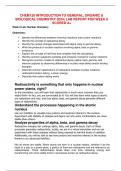
-
CHEM120 INTRODUCTION TO GENERAL, ORGANIC & BIOLOGICAL CHEMISTRY 2024| LAB REPORT FOR WEEK 6 SCORED A+
- Exam (elaborations) • 6 pages • 2024
- Available in package deal
-
- $10.49
- + learn more
CHEM120 INTRODUCTION TO GENERAL, ORGANIC & BIOLOGICAL CHEMISTRY 2024| LAB REPORT FOR WEEK 6 SCORED A+ Week 6 Lab: Nuclear Chemistry Objectives: ● Identify the differences between chemical reactions and nuclear reactions. ● Identify the concept of radioactive decay. ● Identify the nuclear changes associated with alpha, beta or gamma decay. ● Write the products of nuclear reactions involving alpha, beta or gamma emissions. ● Explain the concept of half-lives and complete half-l...
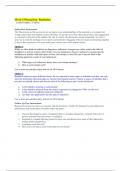
-
CHEM 120 Week 6 Discussion; Radiation (Option 2; Topic of Uranium-238)
- Other • 2 pages • 2023
- Available in package deal
-
- $18.48
- + learn more
Initial Post Instructions The Discussions in this course are set up deepen your understanding of the material as you make real world connections and employ creative thinking. To get the most from these discussions, full engagement is expected on the part of the student. Be sure to stop by the discussion section frequently, not only to post, but to read the postings of your peers and instructor. Engaging with your peers and learning together is key to this experience. For your initial post, choo...
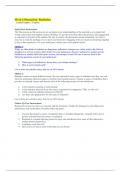
-
CHEM 120 Week 6 Discussion; Radiation (Option 1; Radioisotope Tc-99m)
- Other • 2 pages • 2023
- Available in package deal
-
- $18.48
- + learn more
Initial Post Instructions The Discussions in this course are set up deepen your understanding of the material as you make real world connections and employ creative thinking. To get the most from these discussions, full engagement is expected on the part of the student. Be sure to stop by the discussion section frequently, not only to post, but to read the postings of your peers and instructor. Engaging with your peers and learning together is key to this experience. For your initial post, choo...

-
CHEM 120 Week 8 Final Exam 2023(100% CORRECT SOLUTIONS) | Already GRADED A.
- Exam (elaborations) • 22 pages • 2021
- Available in package deal
-
- $12.49
- 10x sold
- + learn more
6. (TCO 6) A gas at a temperature of 95 degrees C occupies a volume of 165 mL. Assuming constant pressure, determine the volume at 25 degrees C. Show your work. (Points : 5) Using Charles’ Law, ( V1/T1) = (V2/T2). First, convert temperature to KELVIN (T1 = t1 +273) Thus, T1 = 95 + 273 = 368. We have V1 (165 mL) & T2 = (25 + 273) = 298. V2 = (V1*T2)/T1 = (165 mL*298)/368 = 133.6 mL. 0 7 Short 16 7. (TCO 6) A sample of helium gas occupies 1021 mL at 719 mmHg. For a gas sample at constant tempera...
CHEM 120 Week 6 Virtual Lab; Nuclear Chemistry.

How much did you already spend on Stuvia? Imagine there are plenty more of you out there paying for study notes, but this time YOU are the seller. Ka-ching! Discover all about earning on Stuvia

